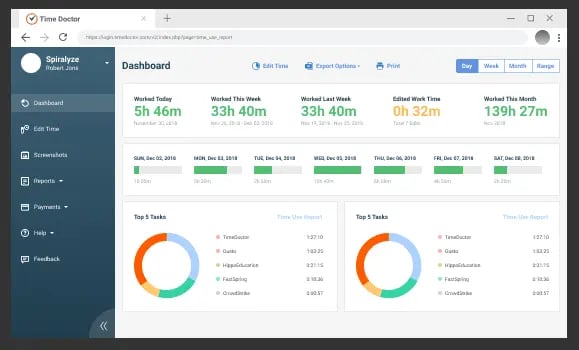Many companies are now adopting remote work. While enjoying the benefits of remote work, there must be more than a few managers and managers who feel uneasy about lack of communication and attendance management.
In this article, we will introduce the basic knowledge of remote work, the advantages and disadvantages, the tools that are indispensable for the remote work environment, and the points to note when introducing it.
Please refer to “people who want to introduce remote work in their company”, “people who want remote work”, and “people who have become new remote workers”.

What is remote work?
Remote work is a word that combines remote and work, and refers to a work style that works away from the company.
Let’s organize the definition of remote work while keeping in mind the difference from “telework”, which refers to working outside the company.
Difference between remote work and telework
There is a word “telework” that is very similar to remote work. Both remote work and telework refer to flexible working styles that are not tied to the office , and there is no big difference in meaning.
On top of that, the difference between telework and remote work can be summarized in the following two points.
Jobs that are easy to work remotely
It can be said that it is difficult to prepare a remote work environment in industries that mainly work with people, such as medical workers, hairdressers, and supermarket salespeople.
On the other hand, remote work can be adopted in many industries if the work system is devised and the necessary environment is prepared.
For example, it will be easy to introduce if the industry meets the following conditions.
- It can be said that it is easy to adopt remote work in industries that are not bound by location, such as office work that can be done without a specific location.
If you mainly work on your PC, you can do the same work at home, and you can also use your smartphone to proceed with your work. - Industries and businesses that do not require face-to-face communication and
can replace face-to-face communication with phone calls, emails, video conferencing, etc. will also find it easier to introduce remote work.
Even in industries that basically require face-to-face meetings, such as medical care, there are initiatives such as remote medical interviews for people living in rural areas.Let’s question the premise of our work, saying, “Actually, we don’t necessarily need to meet face-to-face.”
Advantages of introducing remote work

Remote work has the following six advantages.
- Cost reduction
- Commuting time reduction
- Improving employee work-life balance
- Wider range of employment
- There is a high possibility that operations will not be completely stopped even in an emergency.
- Improving employee work-life balance
Let’s take a look at what can be gained by introducing remote work for these six points, based on the current problems.
1. Cost reduction
The first advantage of introducing remote work is the reduction of overhead costs. Possible cost savings include:
- office space cost
- energy cost
- commute cost
- paper cost
Let’s take a closer look at each.
・Office space costs
Office costs account for a large proportion of a company’s expenses. By introducing remote work, it is possible to reduce office space for employees who do not come to work.
A company that switched 10% of its employees to remote work achieved annual cost savings of around 15 million yen by reducing office space.
Another company has turned its sales office in Tokyo into a fully virtual office and switched all employees to remote work. As a result, annual fixed costs were reduced by 30%.
・Energy costs
Electricity costs account for the largest amount of utility costs for office maintenance. Remote work can also reduce electricity bills.
In May 2011, when power supply shortages were predicted after the Great East Japan Earthquake, the Ministry of Internal Affairs and Communications conducted a trial calculation to see how much power consumption would be reduced if people switched to working from home.
As a result of the trial calculation, it was estimated that 14% of electricity per person per day could be reduced if employees switched to working from home.
・Commuting costs
According to the “Comprehensive Survey on Working Conditions” issued by the Ministry of Health, Labor and Welfare in 2015, on average, companies bear a monthly commuting allowance of 11,462 yen per employee.
Switching to remote work eliminates this commute cost.
・Paper costs
Although it depends on the type of business, going paperless in the office will improve operational efficiency and lead to cost reductions.
Hokuriku Bank, which has 4,300 employees, achieved a cost reduction of 100 million yen as a result of promoting a thoroughgoing paperless operation.
2. Reduced commute time
Long commutes are not only costly, but also productivity and health-related.
According to the Ministry of Internal Affairs and Communications’ “Social Life Basic Survey” issued in 2016, the average commute time is 52 minutes. However, there are statistics that more than half of the people in the Tokyo metropolitan area spend more than an hour.
If you work from home, your commute time will be zero .
3. Improving employee work-life balance
Telecommuting offers great benefits for those who are raising children, caring for family members, or who have disabilities or illnesses.
On the company side, introducing telecommuting may also lead to the retention of experienced employees.
4. Wider range of employment
If remote work can be introduced as a mechanism, there is also the advantage of expanding the range of employment.
For example, it would be easier to create an environment in which even people whose work styles become irregular due to family circumstances can work flexibly through remote work. In addition, since there is no need to commute, you can search for candidates from all over the country or from other countries without being bound by the place of residence of the candidate.
5. There is a high possibility that the business will not stop completely even in an emergency
Considering the risk of business being suspended in the event of a disaster, there is the advantage of being able to manage risk by adopting remote work.
If the risk of disasters is dispersed through remote work, it will be less susceptible to the effects of traffic paralysis, and it will be possible to continue operations to some extent. If the business can continue to some extent without completely stopping, the possibility of quick recovery from an emergency increases.
6. 90% of experienced people want to continue
According to a survey conducted by Nikkei HR on 700 people who have experience working from home, 88% of them still want to work from home.
Disadvantages of remote work
While remote work has many benefits, it also has its drawbacks. It is necessary to understand the disadvantages and take measures to suppress them and incorporate only the advantages.
The three main disadvantages of remote work are:
- Increase in attendance management and project management costs
- security risk
- Tool introduction/education cost
Let’s take a closer look at these three points.
1. Increase in attendance management and project management costs
Remote work cannot be fully utilized without a system for attendance management and project management.
In 2020, XYMAX Research Institute conducted a survey of companies that introduced telecommuting during the state of emergency declaration. Among them, when asked about “problems and issues related to working from home”, 41.7% of companies answered that “management (work, attendance, evaluation) is difficult.”
Even among management who are hesitant to introduce remote work, there are many who find it difficult to manage attendance because they cannot see their employees working.
However, by using attendance management tools and project management tools, it is possible to visualize the results and work styles of employees .
2. Security risk
In order to carry out work remotely, data must be taken out of the company. In doing so, you need to understand where you are exposed to security risks.
- When using public Wi-Fi
- When saving the file to the terminal
- When using file sharing software
In addition to the above three points, there are also risks such as forgetting your mobile terminal or PC, or being spied on when you leave your seat.
Tool introduction/education cost
Communication tools such as conferencing and chat tools are essential for proper remote work.
In addition to introducing the tool, in order to properly use the tool, it is necessary for not only employees but also the management department to understand how to use it.
In addition, training opportunities for new and inexperienced employees are reduced. Remote work will require a more thoughtful program than a regular training course.
While introducing remote work can reduce commuting expenses and office costs, there are also costs required for introducing remote work.
In order to achieve results with remote work, it is necessary to establish a prospect for the payback period along with appropriate cost management.
What mindset is needed for remote work?
When implementing remote work, the following skills are required for individuals who work remotely.
Keep your requirements concise in text
During remote work, text communication such as email and chat will increase.
You often have to ask for advice or work without being able to see the other person’s situation, so be careful to summarize it in a concise and easy-to-understand text so as not to take up the other person’s time .
practice self-management
Unlike the office, everyone can easily lose their minds at home or in a cafe where no one is watching, or on the contrary, they can be so absorbed in their work that they can’t take a break and become exhausted.
Build an environment that allows you to switch by yourself, such as separating your work time from your private life and setting up a work-only space.
have a strong sense of security
In remote work, you leave the company and manage your PC and business terminals by yourself.
In addition to acquiring general security knowledge, it is important to know the risks of accessing confidential company information from outside the company and to have security awareness.
For example, many people work remotely at a cafe, but it is best to avoid doing so when dealing with highly confidential information.
Summary of useful tools for introducing remote work

In order to take full advantage of remote work, it is necessary to build a remote work system. We will introduce the tools necessary for building a remote work system from the following six points.
- project management
- File sharing
- communication
- Attendance management
- Personnel assessment
- Customer management
1. Project management tools
A project management tool allows the entire team to manage the tasks that an individual is in charge of.
There are many project management tools out there, but Asana is so intuitive that even first-timers can write, write, and manage tasks while seeing how others are using it. You can also link with other tools such as Slack.
Based on Toyota’s Kanban system, it is a tool that allows you to manage tasks as if you were sticking sticky notes on a board. It can also be linked with Google Drive and Slack.
2. File sharing tools
You can share files in real time, and you can separate functions such as viewing and editing for each status.
All Google-related tools such as Google Drive, G-mail, and digital whiteboard Jamboard. Administrators can set how members share Google Drive and folders.
3. Business chat tool
It is a tool that allows you to manage projects and share files while communicating and linking with other tools.
Slack is a business chat tool. By using the function called “channel”, you can chat and share files for each project.
4. Attendance management tool
It is a tool that enables attendance management of remote employees.
・Time Doctor

5. Personnel evaluation tool
In remote work, conventional evaluation criteria cannot be used in terms of personnel evaluation, and there may be variations depending on the person in charge.
Set standards for remote work in advance and employ tools to manage it to reduce variability and inequality.
This is a tool that creates a database of personnel information. It is designed to visualize employee information and evaluate employees from different perspectives.
《Price plan》
Inquiry required
6. Customer management tools
Customer management tools are used to record information such as customers and prospects and to approach them according to their status.
The usefulness of customer management tools lies in managing customer information and connecting business opportunities to results through appropriate approaches. It also has the advantage of being able to
HubSpot is our integrated CRM platform (customer management tool) .
Since customer information can be centrally managed across multiple departments such as marketing, sales, and customer support, smooth cooperation between departments is realized.
Since all customer information is aggregated in CRM, marketing staff can check the progress of each project without asking sales staff, and sales staff can see who made what kind of inquiry without asking customer support. is available for verification.
As a result, there is no impact even if employees are in different locations, and work can be carried out without problems even in a remote work environment.
In fact, we at HubSpot ourselves are using HubSpot CRM, and almost all of our employees are working in a fully remote environment, but there have been no particular problems.
In addition, you can work more efficiently with remote work by linking with various tools.
For example, it can be integrated with “Slack”, and you can set it to notify Slack as soon as a prospect visits the pricing page of your website. It will be useful if Slack is the main communication of the company. (Of course, we also use it.)
Points for introducing remote work

In April 2020, in response to the declaration of a state of emergency due to the new coronavirus, many companies that suddenly introduced telecommuting felt that there were problems with telecommuting.
In early June 2020, when the state of emergency was just lifted, XYMAX Research Institute conducted a survey of companies nationwide on “work styles under the corona crisis.” Many companies have taken measures such as working from home and are actually evaluating the results.
However, about half of the companies feel that there is some sort of “impediment”.
As reasons, more than 70% of respondents answered that “there are tasks that cannot be done while working from home”, followed by “insufficient paperless support (45%)” and “insufficient digitization of approvals (hanko culture) (44.8%). %)” follows.
Jobs that cannot be replaced by working from home, such as sales and field work, will likely remain in the future.
However, you can see that there are many areas that can be improved simply by introducing advance preparations for successful remote work, such as going paperless, communication problems, and attendance management.
Based on that, the following four things can be summarized as the minimum preparations for the introduction.
- Go paperless
- Conduct training programs for remote work
- Take advantage of regular remote meetings
- Systematize a place where you can consult via chat
1. Go paperless
Paperless in-house is a prerequisite for remote work.
By digitizing documents and uploading them to a server, authorized people can remotely access them from anywhere. Therefore, simply going paperless can be expected to improve operational efficiency.
However, in the case of companies that have not progressed to paperless, the amount of work and effort may be enormous.
It is necessary to introduce an electronic documentation system and systematically start with the ones that are most frequently used.
2. Implement a training program for remote work beginners
Employees who have never worked remotely tend to feel lonely when they start working remotely.
Appropriate telework training programs are necessary to improve the quality of work and the quality of life during remote work.
At the same time, management personnel also need to learn how to manage remote work. Depending on the company, it may be necessary to prepare training for administrators who tend to feel uncomfortable with IT tools.
3. Take advantage of regular remote meetings
With remote work, where employees work apart, the role of meetings becomes even more important than normal business. Therefore, it is necessary for everyone to understand the know-how for efficient meeting management.
In order to operate the remote conference efficiently, prepare the following in advance.
- Decide on the rules of the meeting and everyone will follow the rules (e.g. the meeting will end within 20 minutes, etc.)
- The organizer sets the purpose of each meeting and evaluates whether it has been achieved after the meeting.
- Arrange a facilitator to facilitate the meeting
- Share the meeting agenda with everyone
- The person in charge gives data and materials to participating members in advance
4. Systematize a place where people can consult via chat
We will consciously communicate with team members by setting up “coffee chats” where employees can feel free to discuss things they do not understand, concerns about work, or discuss progress.
Notes on remote work
As explained in the benefits of remote work, when properly introduced, remote work can produce great results.
Accumulation of experience is necessary to achieve results
In May 2020, Recruit Management Solutions conducted a “Telework Emergency Survey” to investigate work-life balance in a telework environment.
As a result, the most desirable results, with high “quality of work” and “quality of life” and reduced “work stress”, were companies with a long history of telework and high frequency of telework.
Conversely, in companies with a short history of teleworking and infrequent telework, both “quality of work” and “quality of life” declined, resulting in an increase in “work stress.”
What you can see from this is that it is important to have a certain amount of time and frequency in order to achieve results with remote work.
Instead of hoping for short-term results, we need to measure and improve in order to achieve long-term results.
to avoid falling into a vicious cycle
Remote work can get you into a vicious cycle.
For example, suppose that a manager is concerned that remote workers cannot be seen, and tries to increase control over employees by contacting them frequently. As a result, employees may receive unwanted calls or become less motivated when they sense suspicion, which may lead to lower performance.
The key to avoiding such a situation is to develop a system to visualize operations.
If you create an environment where you can understand each other’s situation, such as holding regular online meetings to regularly communicate the work status, and introducing tools to visualize the work progress, you will no longer have to distrust your subordinates.
Mechanism for evaluation based on results
In the first place, managers should be concerned about whether everyone is striving toward the achievement of the team rather than worrying about whether they are slacking off. Team members, on the other hand, should focus on working towards achieving their goals, rather than pretending they are working hard.
In modern Japan, the focus is on systems that evaluate employees through the process of how hard they are working. However, it is difficult to evaluate in remote work where you can not see “doing your best”.
It will take time to completely change the company’s evaluation system, but it is possible to partially introduce it through remote work.
For example, if you manage tasks and try to visualize work, you can clarify individual achievements and contributions.
It is important to have appropriate communication so that you do not feel lonely
Remote work significantly reduces the chances of seeing colleagues face-to-face, and some people live alone and don’t talk to anyone all day long. From this, it is necessary to be careful that remote work makes it easier to feel lonely.
Try to set up opportunities for chatting as much as possible even when working remotely.
For example, there are methods such as creating a room dedicated to chatting in a chat tool so that you can take a break and have a casual conversation.
At HubSpot, we also hold regular 1on1s with team members, providing opportunities to talk without any particular need.
<Conclusion> Let’s increase the options for working styles
Many companies that have adopted remote work should have noticed many wastes that have been neglected for many years, such as commuting on crowded trains, useless meetings, and stamp culture.
However, even if it is possible to introduce it on a trial basis, it will not be so easy to introduce remote work continuously because it will be necessary to improve the environment and change internal rules.
An increasing number of companies are gradually introducing remote work, such as allowing only some employees to continue working remotely or allowing remote work one to two days a week.
Communication problems, personnel evaluation problems, and attendance management problems are issues that must be addressed in order to fully introduce remote work.
It is also necessary to create an environment where close communication can be achieved, even if it is not equivalent to offline, such as an environment and effort to communicate what you want to convey to each other even online, and opportunities for communication so that employees do not feel lonely. It will become

